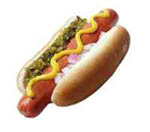
MONDAY, Feb. 22 (HealthDay News) — The leading group of pediatricians in the United States is pushing for a redesign of common foods such as hot dogs and candies, along with new warning labels placed on food packaging, to help curb sometimes fatal incidents of child choking.
“We know what shape, sizes and consistencies pose the greatest risk for choking in children and whenever possible food manufacturers should design foods to avoid those characteristics, or redesign existing foods when possible, to change those characteristics to reduce the choking risk,” said Dr. Gary Smith, immediate-past chairman of the American Academy of Pediatrics’ Committee on Injury, Violence and Poison Prevention and lead author of the organization’s new policy statement on preventing choking.
“Any food that has a cylindrical or round shape poses a risk,” he pointed out. Smith said that hot dogs were high on the list of foods that could be redesigned — perhaps the shape, although he said it would be up to the manufacturers to figure out the specifics.
Hard candies, on the other hand, could be designed so they’re flat rather than round, said Smith, who is also director of the Center for Injury Research & Policy at Nationwide Children’s Hospital in Columbus, Ohio.
The AAP policy statement appears in the March issue of Pediatrics and is the first such guidance on the subject from that group.
“There’s a general recognition that more needed to be done to protect children from choking,” according to Smith. “We have a number of laws and regulations that help prevent choking due to toys. There are no such similar regulations for food.”
Health experts welcomed the suggestions.
“I think it’s very reasonable to strengthen regulations to prevent choking injuries for children,” said Dr. Lee Sanders, associate professor of pediatrics at the University of Miami Miller School of Medicine. “The most common cause of death for kids aged roughly 1 to 5 is choking but it’s also one of the most common reasons for visits to the emergency room and, for kids who don’t die of these injuries, sometimes there are long-lasting injuries or implications,” Sanders said. “It’s a significant public health issue.”
“People should know that grapes are a choking hazard for a certain-age child, that hot dogs are of risk,” added Dr. Mike Gittelman, associate professor of clinical pediatrics in the division of emergency medicine at Cincinnati Children’s Hospital.
The U.S. Food and Drug Administration (FDA) said it would “carefully review the analysis and recommendations.”
“The FDA is concerned about the deaths and serious injuries caused by choking,” said agency spokeswoman Rita Chappelle. “We will also continue to consult with the Consumer Product Safety Commission on assessing choking hazards associated with food and take action against food products that are ‘unfit for food’ on a case-by-case basis.”
Hot dogs are a prime offender, accounting for 17 percent of food-related asphyxiations in children under the age of 10, according to one study.
“If you were to take the best engineers in the world and asked them to design a perfect plug for a child’s airway, you couldn’t do better than a hot dog,” Smith said. “It’s the right size, right shape. It’s compressible so it wedges itself in. When they’re in that tight [it’s] almost impossible, even with the correct training and the correct equipment, to get out. When it’s wedged in tightly, that child is going to die.”
Other high-risk foods include hard candy, peanuts and nuts, even peanut butter.
The policy statement called for the government to establish a “mandatory system . . . to label foods with appropriate warnings according to their choking risk, to conduct detailed surveillance and investigate food-related choking incidents, and to warn the public about emerging food-related choking hazards.”
Manufacturers’ responsibility would be to affix “choking hazard” labels to high-risk products and to consider shapes, sizes and textures when designing products.
“I think there should be a commitment from the entire industry to label not only hot dogs but all high-risk foods with some type of informational label that allows consumers to make informed decisions,” Smith said, adding that he thought companies would figure out that “safety sells.”
The AAP also called on parents, pediatricians and other health-care workers to pay more attention to the issue.
The Grocery Manufacturers Association (GMA) responded, but put special emphasis on the role of parents, teachers and other child care providers in helping keep kids safe.
“Food safety and consumer confidence is the number-one priority of the food and beverage industry. We applaud the attention the American Academy of Pediatrics is bringing to the prevention of choking among children,” the GMA said in a statement.
“We especially agree that the education of parents, teachers, child care workers, and other child caregivers encouraging them to supervise and create safer environments for children is paramount to the prevention of choking among children. We also strongly agree that pediatricians, doctors and other infant and toddler care professionals should intensify choking prevention counseling including providing parents and care givers guidance on developmentally appropriate food selection for their children. We take our working relationships with FDA and USDA [U.S. Department of Agriculture] very seriously and look forward to continuing to work with the agencies to ensure that our products are as safe as possible,” the GMA said.
More information
There’s more on preventing choking in children at the American Academy of Pediatrics.

